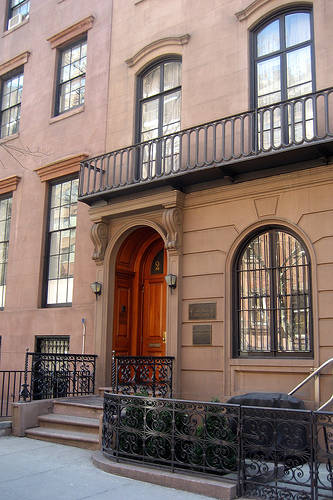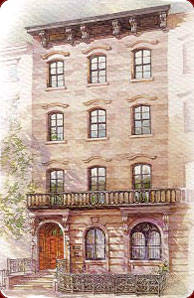NYU's Casa Italiana Zerilli-Marimò. Promoting a Cultural Debate Between Italy & America
When were you appointed Director of Casa Italiana? What does it mean to you?
I have been here since 1994, when I became the vice director of the Casa. Then in 1998 I became the director, a position that I still maintain. In the meanwhile I continued working as a professor at New York University. I consider these two appointments to be extremely connected to each other. Thus I chose to dedicate a considerable amount of my time to them both. I never wanted to give up teaching: it impassions me. It also helps me to better fulfill my tasks as a director. In fact, teaching implies building strong relationships with students, performing personal academic research with proficiency, and also putting forth a great effort in trying to stay informed of the latest news in order to generate topics for class discussion. It this constant training that helps me to keep Casa Italiana very relevant to the interests of young people, of college students.
What characterizes Casa Italiana?
It promotes the Italian culture but, most of all, it enhances the dialogue between the Italian and the American communities. We have never perceived Italy as a product to sell, a country to magnify, or the ideal place to study. Italy is all of this, and it shows. It does not need our promotion. We are not its missionaries. What we consider important is to involve Italy in a cultural debate with the United States. It is relatively easy for us, since we are an integral part of an American university located in New York. This intellectual and geographical position allows us to more readily enhance the dialogue between the Italian and American cultures.
We have also been the first to consider the Italian-American community. Our President, the Baroness Mariuccia Zerilli-Marimò, has understood right from the beginning that studying its culture and characteristics is really important. Thus we have founded the chair in Italian-American studies, the "Tiro a Segno, Fellowship in Italian-American Culture,” part of the department of Italian. We recognize that within the culture of the Italian-American community there is an evolution, a facet, a nuance of the Italian culture itself.
What is the relationship between Casa Italiana and New York University?
NYU is really respectful of the cultural and academic independence of its institutions. The same can be said of our Board of Directors and our founder, the Baroness. We are a popular forum for dialogue. Thus my colleagues, those from NYU together with others from CUNY and Columbia University, always show significant generosity and interest when we ask them to participate to our initiatives. These have become occasions to take the academic debate outside the classroom and thus, to engage the public.
Which aspect of Italian culture are American students more interested in?
I generally divide our students into two categories: those who are getting ready to go to Italy and those who are just coming back. The first group, the “pre-Italy” category, is composed of people who are preparing to study at our branch in Florence. There are about 400 students per semester. They want to study the Middle Ages, the Renaissance…they have a traditional image of Italy, and they consider it to be almost exclusively a country of art and history. The people coming back from Italy, instead, seem to be more interested in contemporary Italy. These students want to study the country from political, economic, and social perspectives.
What do you like most about your job?
I love encouraging people to face issues that they would usually avoid. I love to put together people who otherwise would never meet. In this way, projects, collaborations, and books have been inspired. And it happened within the walls of Casa Italiana. As an example, last year Paolo Mastrolilli presented his latest work here. We had also invited an American publisher. Thanks to that meeting the book will be published in English next spring.
Let’s talk about your upcoming events…
Well, I would like to talk about the exhibitions we will host this year. We are currently showing a series of etchings by Giorgio Morandi, the famous Italian contemporary artist. In November, a photographic exhibition entitled “Tra la Via Emilia ed il West” (Between Emilia and the West). The artist, Paolo Simonazzi, took these photos in Emilia Romagna, capturing landscapes that very much look like the American West. These pictures could have been taken in Arizona! They represent what this part of Italy imagines America to be like. The bars look like saloons, the hostels are motels… In December we will host a completely different exhibition. It is a collection from the Museum of Toys in Canneto dell’Oglio, in the province of Mantova. The town has been considered for the longest time, about 100 years, to be the Italian capital of toys. Through their history, we will retrace a fragment of Italian social history.
Do you partner with other Italian institutions here in New York?
Since we have a similar mission, we mostly collaborate with the Italian Cultural Institute. Our aim is to promote the Italian culture in New York. They do it from an institutional point of view; we do it from an academic perspective. As an example, the exhibition of Morandi’s work is on display at both sites. Moreover, together we organize the “Zerilli-Marimò City of Rome Prize.” We also work in collaboration with the Italian Academy of Columbia University and with CUNY’s, the John. D. Calandra Italian American Institute and Centro Primo Levi for Itailan Jewish Studies
Last question: what is the “Zerilli-Marimò City of Rome Prize?”
The prize is in its ninth year. It is an important initiative because the winning works are translated into English and, consequently, introduced in the American market. Seven of the eight winning books in the previous years have indeed been translated. The event is organized in collaboration with Casa delle Letterature del Comune di Roma (Literature House of the City of Rome). The three finalists will be coming to New York next week and the final winner will be chosen among them. We wish him and his work the same luck his predecessors had!
*******************
Casa Italiana Zerilli-Marimò, home of the Department of Italian Studies at New York University, was founded by Baroness Mariuccia Zerilli-Marimò in 1990.
The institution’s mission is to spread Italian culture worldwide with the belief that Italian culture belongs not only to the Italians but to whomever has the desire to learn about it. know more
(edited by Giulia Prestia)







































i-Italy
Facebook
Google+
This work may not be reproduced, in whole or in part, without prior written permission.
Questo lavoro non può essere riprodotto, in tutto o in parte, senza permesso scritto.